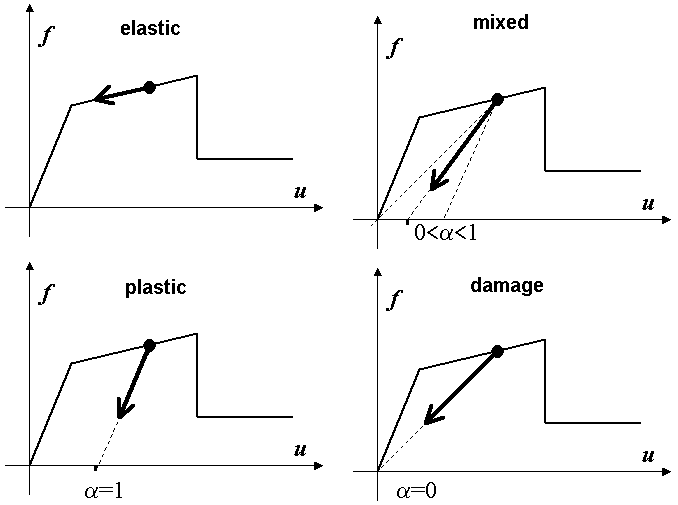The elasto-plastic analysis accounts for material non-linearity. After exceeding yield strength, the rigidity of the material is different from that in the elastic range; besides, after the yield strength is exceeded, unloading can leave deformations from the plastic state. Note that the assumed material non-linearity does not account for the change in material rigidity based on external factors, such as temperature. Rheological issues (change in material properties over time) are also not evaluated.
The following are the characteristics of elasto-plastic analysis in Robot:
- Elasto-plastic analysis is available for 2D structures (2D frames and grillages) and for 3D structures.
- Only normal stresses from longitudinal forces and bending moments are considered. (Tangential stresses caused by transversal forces and torsional moments are disregarded.)
- Elasto-plastic analysis is performed for those bars that you specify. It is assumed that the type of analysis does not change globally for the entire structure. Elasto-plastic analysis is time-consuming and requires defining local conditions for a bar (division of a section or bar, material model).
- Elasto-plastic analysis is performed only for structure bars. It is not available for planar or volumetric finite elements.
Elasto-plastic analysis of bars is performed on several levels: element -> section -> point (material model). Currently, the following analytical methods for elasto-plastic analysis are used:
- Analysis on the element level: Adds global degrees of freedom (discretization of elasto-plastic bar). Bars are divided into smaller calculation elements. Additional nodes and calculation elements are invisible to a user. In each element, stresses are calculated at three points (third-order Gauss quadrature is used).
A method for automatic division can be specified using the Maximum element length option located in the Analysis Type dialog (Analysis menu > Analysis Types > Structure Model tab). It defines the maximum length of a calculation element. You can also define a value for a division parameter using the Division of elements for elasto-plastic analysis option in the Tools menu > Job Preferences > Structure Analysis > Non-linear Analysis dialog. It lets you specify a fixed number for dividing each bar or use the automatic division.
- Analysis on the section level: Calculates stresses or forces in the cross section of an elasto-plastic bar: the layered structure approach; however, a uniform material within a section is assumed.
A section is divided into a set of layers (fibers). In a bi-axially bent section, it is more appropriate to refer to them as zones. In each of the zones, stresses are checked according to the assumed model. Forces acting on the bar axis are calculated by integrating the forces in all section zones. For each zone in a section division, the following parameters must be specified:
- Coordinates (yi, zi) of the point that is the center of gravity of the zone in the central system of a section
- Area of Ai zone
- Mi material assigned to the zone, where i is the zone number (i=1,…, N)
For each load increment, Robot calculates displacement increments at division points along the bar length. Afterwards, based on the displacements, deformations at points in a section are computed. Considering the function that describes a material model, for a given zone, stresses are calculated at each point based on the current deformations. Next, internal forces are calculated based on stresses. At the end, internal forces at all points (zones) are summed (integrated). This iteratative process is repeated until the full load is calculated.
- Material model (the relationship between stresses and strains, the unloading method): Elastic-perfectly plastic or elastic-plastic with hardening: material behavior elastic and linear, in the plastic range - linear with hardening. The model is generated based on the material data using Young's modulus (E) and yield strength (Re).
Currently, based on the assumed method and finite elements used, there are the following limitations of the elasto-plastic analysis:
- Section material is homogeneous.
- Material model exhibits compression-tension symmetry and elasto-plastic behavior with hardening (the analysis works for steel sections).
- The analysis supports rolled sections from section databases and parametrized steel sections defined by a user.
- The analysis does not support bars with tapered section.
- The analysis does not support bars on elastic ground (Winkler's ground).
In the plastic analysis, the unloading method also needs to be specified. It determines the path of a material's behavior after the yield strength is exceeded during unloading, when deformations become smaller. (The deformation gradient is negative.) There are 4 types of material behavior (see the following image):
- Elastic - Return along the same path as when loading. For the non-linear material model, this is non-linear elasticity.
- Plastic - Return along the path defined by the initial modulus of elasticity. The value of parameter is α = 1.
- Damage - Return along the path directed to the point (ε,ς) = (0,0). The value of parameter is α = 0.
- Mixed - Return along the intermediate path between the plastic path and damage path specified by the parameter α : 0< α < 1.

Assuming a uniform material within a section, elasto-plastic analysis is applied to steel sections. The range of the analysis allows for elasto-plastic calculations of steel structures that satisfy the recommendations in EuroCode3.
In the standard non-linear analysis, the load is applied in increments dQ = 1.0 / X, where X is the number of load increments. Consequently, the maximum possible load factor (Q) which can be reached for convergent calculations is Qmax=1.0.
You can use additional criteria of stopping the analysis in the dialog with calculation parameters for a non-linear case. Then the non-linear analysis is performed in such a manner that the maximum load factor Qmax is defined by a user or specified by certain event.